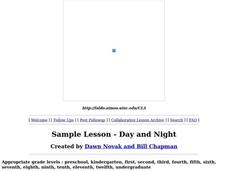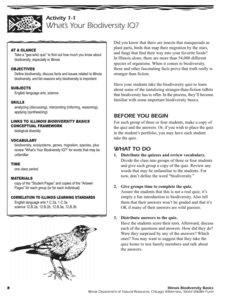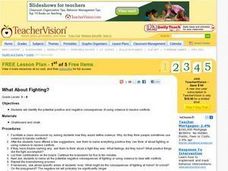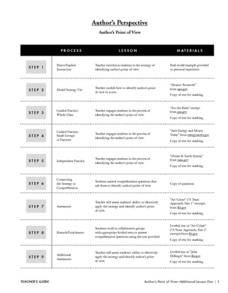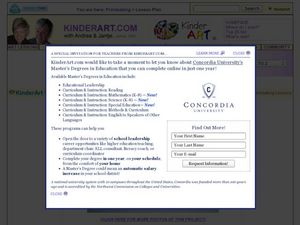Curated OER
Life for the First Inhabitants
Fourth graders trace the emergence and development of culture in Utah. They study the contributions of the American Indian culture on the development of Utah. They create their own rock art by using signs and images that show something...
Curated OER
Day and Night
Students discuss why day and night occur after visualizing a teacher-led demonstration.
Illinois Department of Natural Resources
Section One: What is Biodiversity?
Four intriguing and scientific activities invite learners to explore the natural resources of their town. The activities cover concepts such as genetic traits, organizing species in a taxonomy, the differences between different species...
Curated OER
Lesson 2 Its a Small World (Day 2)
Students are able to explain how the water cycle recycles the earth's water supply. They are able to make use of the knowledge of land forms learned in social studies. Students are able to form a hypothesis on how/why the water cycle...
Curated OER
What About Fighting?
What are the positive and negative consequences of violence? Elementary and middle schoolers discuss how some see violence as the answer to resolving conflicts. They identify the positive and negative aspects to using violence, and ask...
Curated OER
What's So Bad or Good About Conflict?
Learners of all ages discuss how conflict can be negative and positive. First, they create a class bulletin board about conflict, and provide their thoughts and connotations surrounding the word. In a class discussion, they ask questions...
Curated OER
Recycling Copy Paper Scraps
Young scholars discover why recycling is important to Earth. They consider the multiple ways to recycle copy paper. Students transform scrap copy paper with printing on one side into practical classroom tools; an envelope and a...
Curated OER
Convergence with The Cay: Exploring Geographic Concepts Wrapped in a Story
Here's an awesome unit that uses The Cay as the anchor text. The 16-page packet is loaded with teaching ideas, activities, and suggested adjustments.
Curated OER
Do the Research! Arbor Day
In this researching and recording worksheet, students read what and how questions, research the answers, and record them. Students write 5 short answers.
Curated OER
Clowning Around: Drawing
Kids create a clown out of shapes. They work to show emotions while practicing their drawing skills. Pupils use circles, triangles, squares, oil pastels, and their imagination to draw, color, and decorate a sad or happy clown. Tip: Have...
Core Knowledge Foundation
Rocks & Minerals
Take young geologists on an exploration of the rock cycle with this six-lesson earth science unit on rocks and minerals. Through a series of discussions, demonstrations, and hands-on investigations your class will learn...
Curated OER
Weather and Wind
Students study wind and its effect on weather. In this investigative lesson students write a report on wind and weather and create a movement sequence.
Curated OER
African Mask
Students research the importance of masks to the African culture. In this African mask lesson, students design original masks using a variety of materials. Students use the template provided to create their masks.
Curated OER
American Frontiers
High schoolers study the settlement of the American frontier through literature. In this literature lesson, students read and discuss works by James Fenimore Cooper, Bret Harte, Mark Twain, Willa Cather, and Hamlin Garland. High...
Curated OER
Science Fiction Stories
Students write a story. In this genre lesson, students read a science fiction story and discuss its characteristics. Students brainstorm a list of things that if scientifically changed would alter the way we live our lives. Students...
Curated OER
Hunters and Gatherers
Sixth graders participate in mapping and other activities to understand why ancient civilizations developed as they did. For this ancient civilization lesson, 6th graders recognize that there were three important climate zones and...
Curated OER
Mother's Day Lesson Plans
Mother's Day lessons provide students a way to learn about art, music, and history.
K5 Learning
The Moon
Second graders read a short informational text passage about the moon and answer a series of questions based on what they read.
Curated OER
Don't Let the Earth Down
Writing a persuasive argument starts with a clear thesis. Using this resource, your class will write a persuasive paper on a conservation issue. They will then transform their argument into a 30-second public service announcement. If...
Curated OER
Don't Let the Earth Down
Although recycling is definitely beneficial, reducing our waste and conserving our natural resources should really be the focus of environmentalists. Encourage the future generation to create a public service announcement about a...
Take 10
Author’s Perspective
Gradually build understanding of author's point of view through a scaffolded set of exercises. Moving from direct instruction, to collaborative work, and eventually to independent practice, these steps will assist your class in...
Road to Grammar
100 Ice-Breaker Questions
What if you could ease your English language learners into class with engaging questions? You can do just that with these questions. The questions, designed to prepare learners for working with English, are grouped by topics, such...
Read Works
Trading Pumpkins
Can you imagine a pumpkin patch without pumpkins? Learners read how Tammy's family solves their problem in a cooperative way, followed by a set of 10 reading comprehension questions.
Curated OER
When is a Block, not a Block?
Young scholars use a stamped shape image to create a piece of imaginative art. For this stamped art lesson, students use a stamped shape as a starting point to create their own imaginative piece of art that incorporates the stamped shape.



